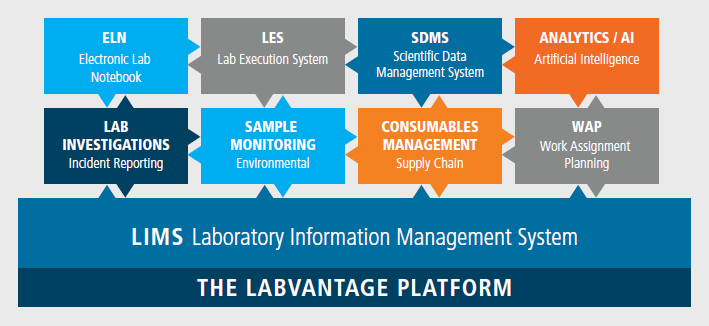It’s widely acknowledged that innovation drives a company’s growth and product development, and for organizations with research and development labs, these environments are central to that innovation.
Traditional laboratory software is built to manage workflows, but these systems often fail to address the modern challenge of enterprise data flows. Today, an organization’s success increasingly depends on how effectively data moves across the enterprise to support informed decision-making.
Organizations that struggle to extract value from large volumes of data, or that aim to get more from their investments in data science and artificial intelligence (AI), can benefit from adopting a scientific data management platform as part of their digital infrastructure.
Integrating laboratory environments with the broader enterprise ecosystem enables organizations to better utilize the vast data lakes produced by labs.
Labs need to evolve from standalone units into strategic assets that are deeply connected to the organization’s data architecture. A digitally native platform approach can help streamline this shift, making scientific data flow management more efficient and impactful.
This article looks at how adopting a platform-based approach to scientific data management, incorporating advanced analytics, semantic search, and lab automation, can enhance enterprise-level decision-making and lab efficiency, ultimately leading to more discoveries and stronger product pipelines.

Image Credit: LabVantage Solutions
Maximizing scientific data in business decision-making
Organizations aiming to make the most of digital transformation and to harness scientific data for business decision-making stand to gain from implementing a comprehensive scientific data management platform. This type of platform connects R&D labs, QA/QC in manufacturing, and more, while also providing access points for supply chain partners.
Unlike siloed software systems, a digitally native scientific data management platform fully leverages organizational and external data, builds AI-enabled digital labs, and enables enterprise-wide data flows that support the entire product lifecycle—from early-stage concepts to full-scale commercialization.
Whether the focus is on industrial chemicals, pharmaceuticals, fuels, or food, an integrated platform ensures optimal lab performance and unlocks advanced analytics. The result is sharper insights, more informed decisions, and, ultimately, greater innovation and sustained growth.
The disadvantages of siloed informatics
Key laboratory information has traditionally been housed in standalone systems, making it difficult for staff to locate, access, integrate, or reuse data effectively. These siloed solutions also restrict an organization's ability to enhance business processes across internal systems and supply chain partners.
At the same time, organizational data lakes hold immense potential for researchers aiming to drive new discoveries, extend product life cycles, or improve manufacturing efficiency.
However, when this data remains inaccessible, it can lead to missed opportunities. Researchers may be unaware of existing institutional knowledge, waste time and resources duplicating experiments, or find themselves manually piecing together data from multiple applications just to get a complete picture.
The impact of inaccessible data extends beyond R&D. QA scientists may lack access to crucial development data that could improve manufacturing outcomes and enhance product quality attributes. As a result, they often spend time on repetitive, low-value tasks instead of focusing on optimization and innovation.
Business leaders are also affected. Without visibility into lab activities and analytics, executives may struggle to gain clear insight into ongoing research, product pipelines, or the data needed to make informed investment decisions.
By reducing data fragmentation and implementing dashboards and other visualization tools, organizations can empower decision-makers at every level to better evaluate, validate, and analyze diverse data sources.
Achieving a seamless data flow
Organizations of all sizes pursue digital transformation to boost productivity, improve efficiency, and reduce costs, while maintaining a strong focus on innovation.
Industry observers such as Frost & Sullivan1 argue that a platform approach to lab informatics represents a solution to these challenges.
Frost & Sullivan’s Frost Radar™ report on LIMS for the life sciences states that “users expect more from vendors, and vendors want to become end-to-end lab informatics solution providers rather than simply offering traditional laboratory information management systems [LIMS].”
Today’s LIMS are far more advanced than earlier versions, often integrating features like electronic lab notebooks (ELN), scientific data management systems (SDMS), and lab execution systems (LES). Yet even with these expanded capabilities, they still fall short of fully supporting modern business processes.
Frost & Sullivan point out that organizations are demanding more—prompting a push for platforms that incorporate artificial intelligence, machine learning, and natural language processing.
These capabilities, they report, “would allow researchers and labs to better manage their data and extract insights at a faster pace to save time,” while predicting that AI integrations with LIMS will increase “over the next few years.”
Interest in these platforms is growing, as companies increasingly move away from fragmented solutions in favor of unified scientific data platforms that can seamlessly connect with broader enterprise systems.
By integrating lab data into the enterprise-wide digital ecosystem, organizations can streamline data flows, enabling leaders to bring products to market faster, reduce operational costs, and more effectively respond to customer needs.
The business case for a platform approach
The business case for a platform approach encompasses several areas.
Regulatory compliance
Regulated industries like pharmaceuticals can benefit from the implementation of automated compliance workflows, improving product quality, reducing failure rates, ensure data integrity, and facilitating robust audit trails.
Security and privacy risk
All data traffic is secure, protecting both business and customer privacy from data integrity issues, cyberattacks, and other safety concerns.
Efficiency and productivity
The elimination of data silos helps ensure smooth data exchange and collaboration across cross-functional teams throughout the enterprise. This streamlined approach can lead to stronger product pipelines, more discoveries, less repeat work, and improved adherence to quality parameters.
Moving away from time-consuming, low-value work to high-value science significantly boosts productivity, whether this is occurring in a single lab or across a global network of facilities.
Insights with AI
The integration of innovative AI technology improves data analysis, modeling, and predictions, helping to facilitate robust comparisons of different experiments while enabling deeper scientific insight and more rapid discovery.
Interoperability and standardization
Adhering to standardized protocols and data formats ensures data interoperability, simplifying data exchange and use across different platforms, software, and scientific disciplines.

Image Credit: LabVantage Solutions
SAAS DELIVERY
LabVantage SaaS LIMS helps businesses:
- Reduce risk by improving data security, privacy, and regulatory compliance.
- Adapt to remote data management in response to the growth of work-from-home culture.
- Lower capital costs of cumbersome hardware and on-premises IT infrastructure.
- Stay up-to-date on the latest releases while avoiding disruptive product upgrades.
The LabVantage scientific data management platform
LabVantage pioneered one of the industry’s first laboratory informatics platforms, incorporating this into its LIMS alongside an ELN for flexible R&D, an SDMS for automated data capture, and an LES for compliant workflows.
This platform acts as the hub of all labs across the organization and as a resource across the business. Thanks to its expanded capabilities, the platform can now be used to manage lab investigations, consumables management, sample monitoring, and work assignment planning.
The addition of AI-supported semantic search capabilities and advanced analytics has enabled a digitally native ecosystem that is able to serve the entire product lifecycle, from initial research and development to commercial manufacturing and QA/QC.
Its ability to manage both data flows and workflows allows this ecosystem to reduce operational costs while continuing to drive improvements in productivity, efficiency, decision-making, collaboration, and, eventually, time-to-market.
The entire scientific data platform is delivered with Software-as-a-Service (SaaS) technology, offering its users agility and scalability, and supporting innovation by meeting the FAIR data principles necessary for knowledge sharing and collaboration.
Scientists working in different types of laboratories and across multiple sites and geographies are empowered to do their jobs better, faster, and smarter, while business leaders are afforded the visibility to make more informed decisions on markets, products, and investments.

LabVantage’s scientific data management platform, which integrates solutions within a single architecture, licensing model, and services contract, provides customers with the flexibility to select and activate specific components, and scale use as needed. Image Credit: LabVantage Solutions
Case study 1: Streamlining R&D and QC to develop a tasty non-alcoholic beer
Expanding a successful product line to meet evolving customer preferences can give businesses a distinct competitive edge. A growing consumer interest in non-alcoholic beer is a timely example of this shift in demand.
For food and beverage manufacturers, adapting an existing recipe—or developing a new one—can be a costly and time-intensive process, often requiring multiple rounds of experimentation with various ingredient combinations.

Image Credit: LabVantage Solutions
One beer manufacturer addressed this challenge by using the LabVantage scientific data management platform, along with data from external sources, to identify the optimal formula for a new alcohol-free beer.
By tapping into its existing recipe database and applying AI-powered research, semantic search, advanced analytics, and automation, the company significantly reduced the number of experiments needed to achieve the desired flavor profile.
Once the product was developed, the platform continued to support quality assurance during commercial production. For instance, if a product sample fails quality checks, the issue can be logged directly into the Lab Investigations module. This enables rapid root-cause analysis and timely corrective action, well before the product reaches the customer.
In this case, the use of the LabVantage platform helped the company cut research and development costs, shorten time to market, lower risk, and reduce quality concerns.
The leading LIMS for growth and innovation
Frost & Sullivan named LabVantage the top growth and innovation leader in its LIMS report and Radar™, recognizing the company’s strong position in a competitive landscape.1
Few vendors currently offer the level of integration LabVantage provides—combining LIMS with advanced scientific data management, analytics, and connections to enterprise systems beyond the lab.
LabVantage earned high marks for its “comprehensive portfolio” and “commitment to continued innovations.” Frost & Sullivan also highlighted several of the company’s key advancements.
Frost & Sullivan also highlighted a number of LabVantage’s innovations.
One standout feature is LabVantage’s application-specific solutions, which support particular industries and lab types with preconfigured workflows, enabling faster deployment and streamlined adoption.
The company’s product portfolio continues to grow through a mix of internal development and external technology acquisitions, including investments in AI and natural language processing (NLP) that support scientific and unstructured data management.
A notable example is LabVantage’s 2022 acquisition of Biomax Informatics, a knowledge management software provider.
Biomax Informatics’ AILANI semantic search solution was recognized in the Gartner® Hype Cycle™ for Life Science Discovery Research 2023, where it was listed as a Sample Vendor in both the “Semantic Knowledge Graph Tools” and “Analytics Platforms for Research Informatics” categories.3
Case study 2: Optimizing raw materials inventory for $2 million annual savings
Laboratory managers and scientists need real-time visibility into stock levels and warehouse inventory to operate efficiently. A digitally native scientific data platform can deliver significant savings across large enterprises by enhancing the ability to detect waste and automate inventory processes.
LabVantage’s Consumables Management module offers a clear example of this impact. It helps identify expired chemicals before they’re used in experiments and tracks ordering and consumption to promote optimal material usage.

Image Credit: LabVantage Solutions
One large paint manufacturer integrated this module into its LabVantage LIMS platform and saw a 90 % reduction in expired chemicals at a single site, translating into more than $2 million in annual savings from reduced chemical waste.
Increased inventory transparency also creates opportunities to share chemicals across labs, cutting down on redundant stockpiles of commonly used reagents. Additionally, the system can quickly pinpoint expired or compromised chemical lots and trace all affected experiments or tests, helping maintain quality and compliance.
Improving data flows from the laboratory to the boardroom
Digital transformation is essential for leaders planning for their organizations’ growth and innovation. Laboratories can no longer operate as their own islands, equipped with individual applications designed to support lab-specific workflows.
It is now a strategic imperative that organizations transition to integrated, digitally native solutions that are able to improve the flow of data across the entire ecosystem while effectively leveraging laboratory-centered data lakes. The choice of approach and partnerships in this endeavor are critical to its success.
LabVantage attributes its success in helping customers make this journey to its people, processes, and platform.
This article makes the case for a scientific data management platform approach to a digital enterprise, with case study examples bolstered by industry analysts like Frost & Sullivan.
It is important to work with only the best, most comprehensive, and integrative technologies as part of an organization’s tech stack, with personnel trained and equipped to leverage these effectively.
It is also important to consider the people and processes within a potential scientific data advisor. For example, consider whether the advisor has global operations that can work in parallel with the organization’s, and determine whether a potential advisor is skilled enough in the industry in question to offer appropriate solutions.
A potential scientific data advisor must be able to offer appropriate assistance as an organization evaluates, plans, and implements its transformation, supporting its client to understand and prepare for the change management required with novel and accessible solutions and processes.
LabVantage is uniquely positioned to deliver its modern scientific data platform to global organizations of all sizes and industries, thanks to its significant investments in its Customer Care and Professional Services Organization.
These advantages are key to supporting LabVantage’s customers in making smarter, data-driven decisions that drive innovation and growth.
References and further reading
- Frost & Sullivan (2023). Life Sciences Industry Trends | Life Sciences LIMS Market Analysis. (online) Available at: https://store.frost.com/frost-radartm-laboratory-information-management-systems-for-the-life-sciences-industry-2023.html (Accessed 28 May 2025).
- McKinsey & Company. “Digitization, Automation, and Online Testing: The Future of Pharma Quality Control.” McKinsey & Company Life Sciences. Available at Digitization, automation, and online testing: The future of pharma quality control
- Harwood, R. Gartner® Hype Cycle™ for Life Science Discovery Research, 2023. Available at Hype Cycle for Life Science Discovery Research, 2023
Acknowledgments
Produced from materials originally authored by LabVantage Solutions, Inc.
About LabVantage Solutions
LabVantage Solutions, Inc. is the leading global laboratory informatics provider. Our industry-leading LIMS and ELN solution and world-class services are the result of 35+ years of experience in laboratory informatics. LabVantage offers a comprehensive portfolio of products and services that enable companies to innovate faster in the R&D cycle, improve manufactured product quality, achieve accurate recordkeeping and comply with regulatory requirements.
LabVantage is a highly configurable, web-based LIMS/ELN that powers hundreds of laboratories globally, large and small. Built on a platform that is widely recognized as the best in the industry, LabVantage can support hundreds of concurrent users as well as interface with instruments and other enterprise systems. It is the best choice for industries ranging from pharmaceuticals and consumer goods to molecular diagnostics and bio banking. LabVantage domain experts advise customers on best practices and maximize their ROIs by optimizing LIMS implementation with a rapid and successful deployment.
Sponsored Content Policy: News-Medical.net publishes articles and related content that may be derived from sources where we have existing commercial relationships, provided such content adds value to the core editorial ethos of News-Medical.Net which is to educate and inform site visitors interested in medical research, science, medical devices and treatments.